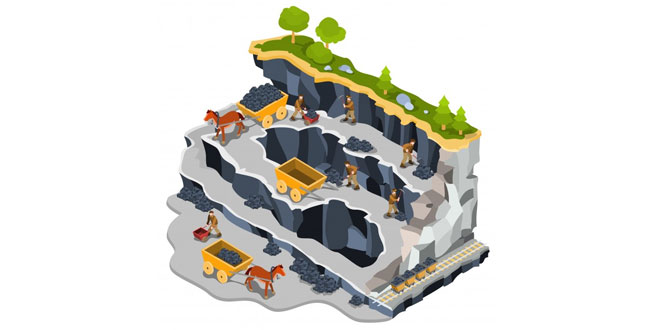Question: Distinguish Between Metallic and Non-metallic minerals
Answer:
Metallic Minerals:
- They can be melted to obtain new products.
- They are usually hard and have shines or luster of their own.
- They are ductile and malleable.
- They are generally associated with igneous rocks.
- When hit, they do not get broken.
- Example: Copper, iron, aluminium, tin, silver, gold, manganese etc.
Non- Metallic Minerals:
- They do not yield new products on melting.
- They are not so hard and have no shine or luster of their own.
- They are not ductile and malleable.
- They are generally associated with sedimentary rocks.
- When hit, they may get broken into pieces.
- Example: Sulphur, coal, mica, petroleum, salt, clay, marble etc.
Question: Distinguish Between Commercial and Non-Commercial Energy.
Answer:
Commercial Energy:
- The sources of energy which are used by the people for commercial purposes.
- The use of commercial source of energy can be used as an indicator of economic development of the country.
- Coal, petroleum, natural gas, hydro-electricity are the major commercial sources of energy.
Non- Commercial Energy:
- The sources of energy which are used by the people for home consumption.
- The use of non-commercial source of energy can be used an indicator of living standard of the country.
- Fire wood, charcoal, cow-dung and agriculture waste are the major non-commercial sources of energy.
Question: Distinguish between Anthracite and Bituminous Coal.
Answer: Anthracite and Bituminous Coal
Anthracite:
- This is the best quality of coal.
- It contains 90 to 95% if carbon content in it.
- It is generally formed when the beds of coal are subject to extreme pressure and heat to the earth movements.
Bituminous Coal:
- It is the second in quality.
- It contains 60 to 80% carbon in it.
- It is widely used.
Question: Differentiate Natural Gas and Bio Gas.
Answer:
Natural Gas:
- It is used as source of power in the urban areas.
- It is also used as raw materials in petrochemical industries.
- It takes less time in establishing a power plant.
- Fertilizers are also produced by natural gas.
- Its transportation is very easy. It is transported through pipeline.
Bio Gas:
- It is used mostly in rural areas.
- It is not used as raw material.
- It is derived from farm shrubs, farm wastes animal and human wastes.
- Decomposition of organic matter yields gas which has higher thermal efficiency in comparison to kerosene, charcoal etc.
- Bio Gas plants are set up on Municipal, cooperative and individual basis.
Question: Describe the distribution of iron ore in India.
Answer: Iron-ore is the backbone of modern cultivation. It is used for manufacturing machines and tools. India has about 20% of the world reserves of iron ore. Most of the iron-ore mined in the country came from Chhattisgarh, Jharkhand, Orissa, Goa and Karnataka. Some well known iron-ore mines are in Durg and Dantiwar – a district of Chhattisgarh, Singhbhum district of Jharkhand and Sundargarh, Keonjhar and Mayurbhanj district of Orissa, North Goa, Chikmagalaur and Bellary district of Karnataka.
Question: Describe the distribution of coal in India.
Answer: In Jharkhand, the largest producer where Jharia, Bokaro, Karampur, Palamu are the major coal fields.
In West Bengal, Raniganj, Jalpaiguri and Darjeeling are the coal fields.
In Chhattisgarh, Sarguja, Bilaspur, Raigarh and Bastar districts are coal fields.
Madhya Pradesh has coal fields in Chhindwara district.
In Maharashtra – Chanda is the main coalfield.
Question: Why do you think that solar energy has a bright future in India?
Answer: It is true that solar energy has bright future in India because
- India is blessed with plenty of solar energy because most part of the country receive bright monsoon sunshine.
- India has developed technology to use solar energy for cooking, water heating, space heating, crop drying etc.
- It is most abundant, inexhaustible and universal source of energy.
- India is tropical country.
- It is pollution free.
 Class Notes NCERT Solutions for CBSE Students
Class Notes NCERT Solutions for CBSE Students





